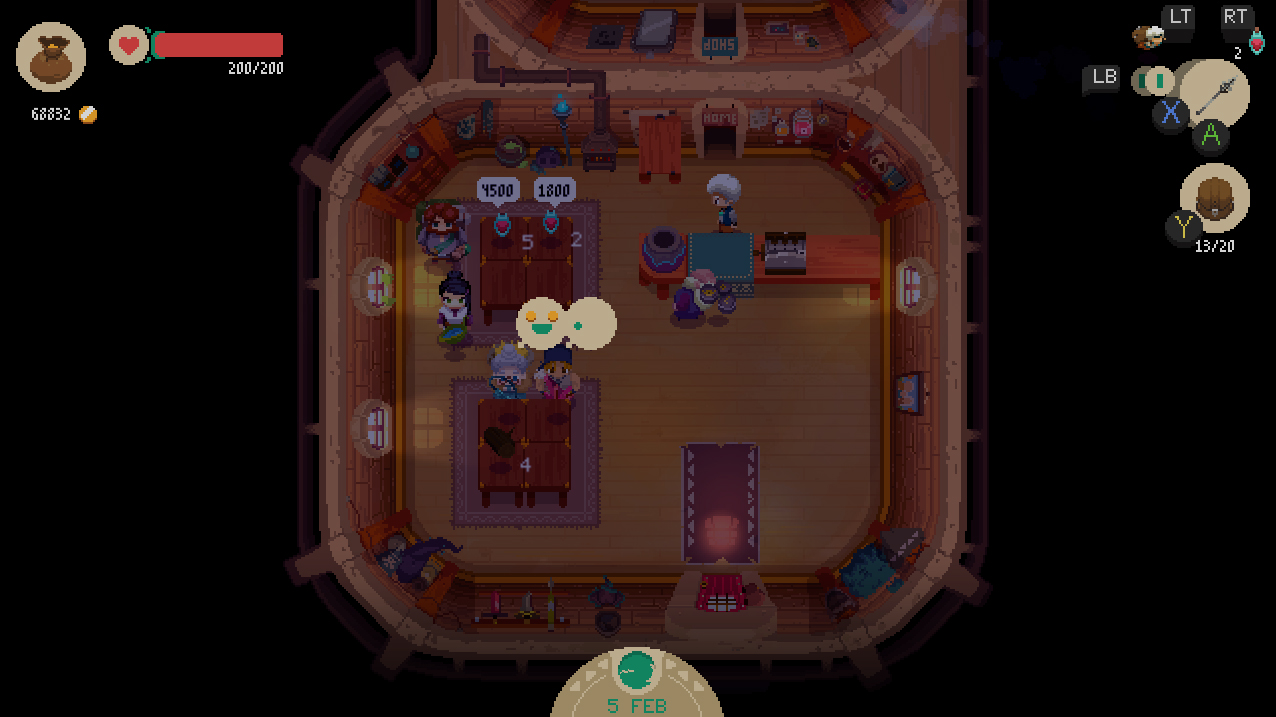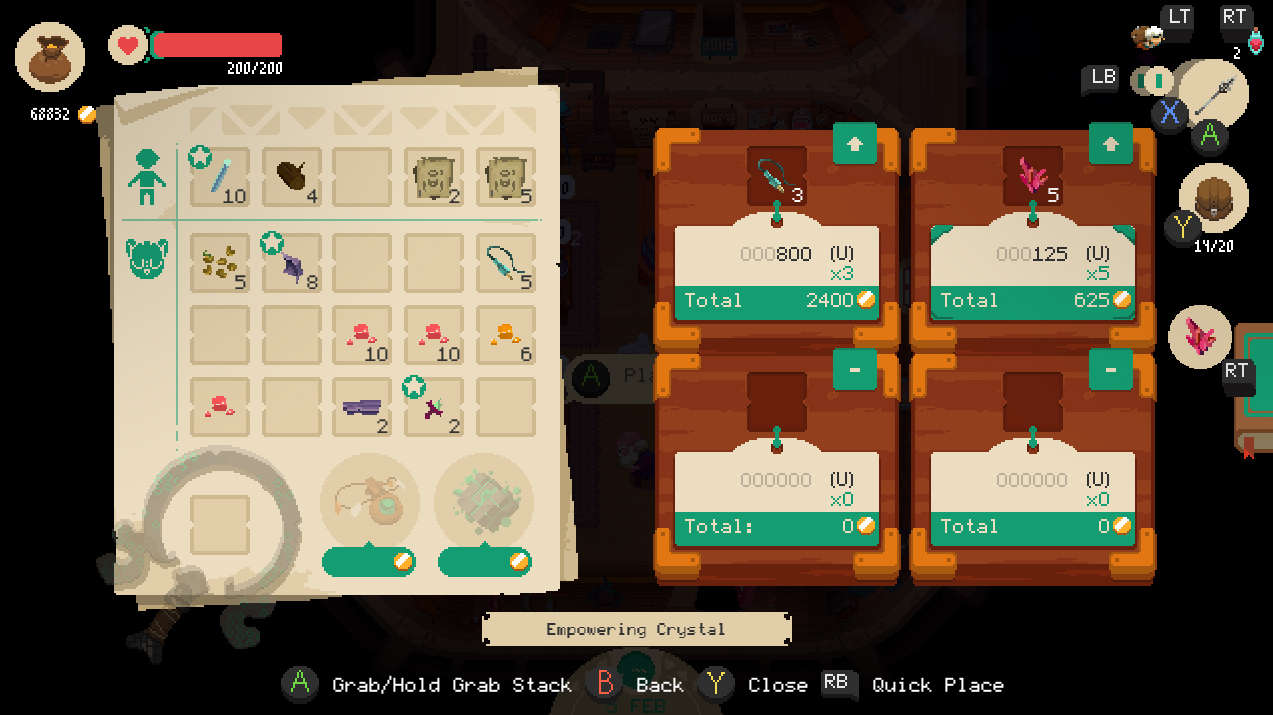Platforms:
Xbox One, PS4, PC
Released:
May 29, 2018
Publisher:
11 bit studios
Developer:
Digital Sun
Long ago, an archaeological excavation uncovered the Gates, portals to other worlds. The areas beyond the Gates, referred to as “Dungeons”, laid as habitats for both fearsome monsters and vast riches. Heroes came from far and wide to attain their fortune. With the influx of heroes came the demand for items, and from the community of item shops sprung forth the commercial town of Rynoka. Will always wanted to be a hero, but fate stood against him. His parents were not heroes, but merchants in charge of the item shop, Moonlighter. His youth was spent learning how to run the item shop. But as time passed, so did his parents, and in his lonely times he trained. Now, under-equipped but determined to brave the gates, he must face the Dungeons and uncover their secrets.
There’s a real fable-like air to Moonlighter. A story of a man separated from dreams by duty and family. It’s so easy to catch yourself rooting for Will to succeed in his passion. The game’s narrative is minimal, although it really only needs to exist to add context to the world and your actions, and the narrative that does exist really fits with the feel of the game. You have to work hard to improve yourself, but you have to also work hard to help those around you. There’s a real duality of purpose, and it reflects well with the design. You can’t just abandon the store and go questing all day. You also can’t just work the day job. Both jobs feed into each other.
The day job sees Will run the item store, in an interesting twist on the tycoon genre. Here you sell loot you get from the dungeons alongside items bought from other vendors in the town. What’s interesting is you have no idea what things are worth at the start. When you plonk down an item on one of your tables for the first time, you’re taking a stab in the dark. As customers look at your wares they’ll visibly react, maybe it’s a bit cheap? Bit pricey? Each new reaction is a step closer to zeroing in on the optimum price point for an item. You can also sell a bunch of items in one go, if the unit price is on point. Just keep in mind the classic supply and demand, flood the market and an item’s popularity can plummet.
The item store is quite the buffet of management games. You’ve got the pricing to figure out, but you also must manage the store during opening hours. Where should items be placed? Some special tables can attract different buyers. Which items should you display? Not only must you avoid oversupplying, but some customers may only be interested in specific items. Time must be managed too. Customers will only wait for so long before they leave with your unpaid items in tow. Throw in a limited inventory leading to trips to the back rooms, and criminals looking to steal your wares, and suddenly timing becomes very important. It feels like a mishmash of Diner Dash and Recettear, but in a good way. There are enough things going on that you must pay attention and sometimes make hard choices. But the concepts are simple and communicated well in the game’s visual language.
The other half of the game is spent exploring the dungeons of Rynoka. Each dungeon has a different theme with different characters and collectibles in the world. Being a rogue-like means that Moonlighter has random dungeons, well mostly random. Each individual room seems to be the same in each run, both in geography and monsters. The randomness comes in the arrangement of those rooms (once again, mostly). There are some design patterns that recur from run to run, just enough to help you navigate more efficiently.
As for the monsters, there is a nice mix of characters with different attacks. Some are very much close quarters, whilst others are designed to do damage from the other side of the room, each with a little twist on things. They’re easy enough to understand and follow, but more than enough of a challenge when the numbers stack up. What’s also fantastic is that there is a real sense that there is no one best weapon in this game. You continue to improve Will’s kit at the blacksmith as you progress and he can wield any two weapons of choice: sword and shield, large sword, spear, glove (for monster punching, naturally), or a bow with infinite arrows. Large swords let you do powerful spin attacks, but the slowness can leave you open. Arrows free up movement and let you snipe from a safe location, but if you’re swarmed it won’t do lots of damage quickly. Also having two kits is fantastic, letting you account for a weapon’s weakness with the strength of another.

But no man can brave the Dungeons alone. Money plays a big factor in this game for a myriad of purposes. You’ve got to pay the piper to teleport out of a dungeon with your loot. But, money can be used to improve things in Rynoka. If you have the cash, the Town Board lets you make improvements to the shop or town. Shop improvements will increase the number of items available at any time, likelihood to receive tips, more storage, and so on. Town improvements open up new vendors to visit. A Blacksmith for your armour and weapons and an alchemist for potions are unsurprisingly the first cabs off the rank. Get some materials together and you’ll be upgrading and healing your character in no time. Not to mention, swords, potions? They sell at a tasty little profit margin.
The last thing that must be said is the game is just like unfairly beautiful. I think games manage to nail gameplay when even getting from A to B is fun. Moonlighter is the first time I’ve felt similarly impressed by a game’s visual design. I seriously on many occasions looked at menus (MENUS!) and thought that it’s just so freaking gorgeous. To say they knocked this out of the park would be an egregious understatement. It’s all pixelated and lowbit, as is a staple of many indie titles, but it’s more than that. It doesn’t just mimic, it elevates, reaching the heights alongside Owlboy. Once again, its familiar and comfortable and pseudo-nostalgic, like an old fable lost to time. But this game still retains a unique aesthetic. Similarly, music is of a wonderful calibre. Truly this is an audio-visual treat, alongside all its other achievements.
“The game is truly staggering and comes with a big recommendation from yours truly”
The game is truly staggering and comes with a big recommendation from yours truly, but here come the caveats. First up, this game falls a little short on the tutorials. The game starts off strong teaching you about the ins and outs of combat and item shop running. But as the game progresses and you improve the store that’s when things get more complicated. For example the criminals was something I figured out rather than being told. Granted, they had an obvious indicator, a balaclava and beanie icon. But suffice to say, there are things that are less intuitive. I still don’t know if a character with a ‘person holding open his coat’ icon indicates that he intends to sell me something or expose himself. I fear until he finally shows me his wares… in the innocent way.
Other elements are surprisingly unexplained. Whilst exploring a dungeon a few times looking for a specific item a person had ordered for the next day I died a few times. No issues, just “play again”. Little did I know each play again advanced the calendar a day. I would find this out after getting everything for the man’s order that was now inadvertently a week overdue. It all comes back to the question of “why?”. My best theory? The game is being localised in 10 languages, but a smiley face is a universal sign of happiness. Thus they lean into the visual language. Mostly this is easy to notice, after all a heart means health, shield means defence, and a coin sprite means moolah regardless of country. So the visual language often works, but not everything is crystal clear. There is a bit of nuance missing, and it’s hard to ignore that in a game like this. How can a player make snap risk-reward decisions if they don’t understand parts of the game?
Secondly, and this is pretty minor, but there are some bugs here. They are not super often, but they can definitely throw the balance a little. The little pea shooter enemies are probably the most glitchy. I would stand behind one of these guys and chuckle about how they were facing away from me. I would then get shot at seemingly not from the mouth cannon, but presumably out of their butt. In case it isn’t clear, they are not supposed to do that. The only really upsetting glitch was a door I clipped through. It didn’t kill me, it didn’t crash the game, but it arbitrary meant I had to destroy a bunch of progress.
Positive:
- Beautifully designed and rendered pixel graphics
- Interesting item shop and dungeon crawl gameplay
- Fable-like story and progression systems
- A unique mix of genres that perfectly compliment one another
Negative:
- Some mechanics are left for the player to work out
- Occasional minor glitches
I’m surprised to say Moonlighter managed to exceed my high standards. There’s a real duality that seems to flow through everything here. You slide from the (at times) peaceful quiet of the item shop to the sometimes technical and nerve-racking dungeon crawls. The design has pixelated graphics but the palette and overall fidelity make it something distinct from any possible sources of nostalgia. You can practically feel the love and care stitched into this game. I will say I will look forward to a Moonlighter wiki patching the gaps in the tutorial. But otherwise, this is an utterly fantastic game, and I will be showering this game with praise for quite some time.














